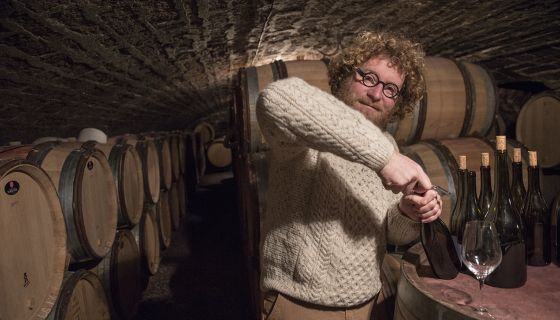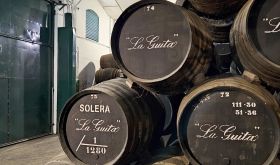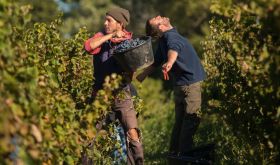From £27, €34, $59, 7,920 Japanese yen, 11,785 roubles
Which Burgundian manages to make truly excellent wine of all three colours? The clue is in the title of this article of course. But it’s probably Sylvain Pataille’s pink wine that is his most distinctive. He is very serious about his aim to make the best rosé possible, devoting his finest vines to it.
(One could, incidentally, add as a fourth string to his bow – his exceptional prowess in making Aligoté, five different cuvées in 2019 alone, as described in my tasting article 2019s tasted in Burgundy – M to T. Pataille founded Les Aligoteurs, a group of great winemakers dedicated to re-evaluating Burgundy’s second white-wine grape, an initiative that is particularly well-timed in view of the increasingly warm growing seasons there.)
Pataille has been making a serious, utterly burgundian dry rosé since 2002 and I agree that it certainly is one of the world’s finest rosés. (Another, spookily similar, example is the rosé of Domaine de l’Horizon all the way south in Roussillon. Go figure. Perhaps it’s the sensitivity of the extended oak ageing and the food friendliness they have in common.)
This is not the first time a Pataille wine has featured as a wine of the week. See this Marsannay Rouge chosen in 2017. You can read quite a bit about Pataille’s background in that article but he is a bit of an anomaly in Burgundy, having studied oenology not in the Pinot-centric school in Dijon but in the much broader context of Bordeaux University. Partly because of this, he has a vast network of contacts, particularly younger vignerons, and not just in Burgundy. His brother worked as a viticulturist for the famous Pouilly-Fumé estate Château de Tracy. Pataille long consulted as an oenologist in Burgundy although today advises rather fewer domaines than he once did. The combination of all this means that he is constantly on the phone, in between telling stories of wines made and tasted, but in an entertaining rather than exhibitionist way.
I’m told by Toby Morrhall, wine buyer at The Wine Society who has been buying Pataille wines for many years, that he is part of an information-sharing group of current-generation Burgundians that includes Thomas Bouley of Dom Jean-Marc Bouley, Charles Lachaux of Dom Arnaud-Lachaux, Olivier Lamy of Dom Hubert Lamy and Jean-Marc Vincent of Santenay.
As I described in this account of my most recent visit chez Pataille last October, on arrival I explained that, after a week of tasting red and white burgundy, I was particularly looking forward to the novelty of his famous rosé, Fleur de Pinot. As it turned out, he had not been planning to show his rosé but quietly phoned a friend who had access to his bottle cellar, who then turned up with bottles of the 2018 and 2017 rosé. He gave me a taste of the 2020 and 2019 from cask before opening the bottle of 2018. But, seeing that I was flagging towards the end of this last visit of the week, at which Pataille showed no fewer than 20 different 2019s, he suggested I take the bottle of 2017 to try it later. Thank the Lord.
It’s no wonder that this wine is so serious, characterful and as unlike standard rosé as it is possible to imagine. The wine, based on Pinot Noir with a little Pinot Beurot (Pinot Gris), is sourced from three different plots on limestone and clay planted respectively in 1932, 1934 and 1949 and which Pataille reckons are the best vines of his entire domaine. The viticulture is certified organic, the methods biodynamic. Roughly half the grapes are directly whole-bunch pressed to yield almost colourless juice while the other half is given between 36 and 48 hours of skin contact. Fermentation is of course with ambient yeast and the wine is aged for two years in oak.
Tasting the wine at so many different stages in its life was fascinating. In youth it’s both sweet and tannic and looks almost halfway to being a light red, but with time it looks increasingly pale and tastes increasingly dry and subtle.
The vintages in current commercial circulation are 2018, 2017 and 2016. The 2018 is still a little youthful, having been released only very recently, but will grow into something very special. The 2017 is at a great point in its evolution now. I gave it 17/20 and reckon it will be drinking well for the next seven years, believe it or not. My tasting note:
Palest raspberry colour. What a joy! Smells like pungent delicate red burgundy but tastes wonderfully fruity, refreshing and serious. This was truly beautiful with rosette de Lyon saucisson. Real bite on the end and smooth texture. The acidity now dominates the tannin that is evident in younger vintages.
I’m delighted to say that in the UK The Wine Society are exclusively offering the 2017 currently at £27, which is pretty good value for a bottle of fine old-vine burgundy. If you follow the Wine-Searcher link at the top and bottom of this article, you will see considerable variation in the price of this wine.
The 2016 is also tasting well. I wrote about it when I tasted it three years ago:
Bright rose pink. Tight and sweet and pure. Relatively low acid and lots of pretty fruit. Certainly very Pinot. Practically winks at you it’s so appealing. Long.
The wine is available only from The Wine Society in the UK but is also on sale in France, Belgium, Germany, Italy, quite widely in the US, and in Japan. And Russia, to judge from Wine-Searcher, although the Russian retailer seems to be asking the equivalent of £116 for it.














